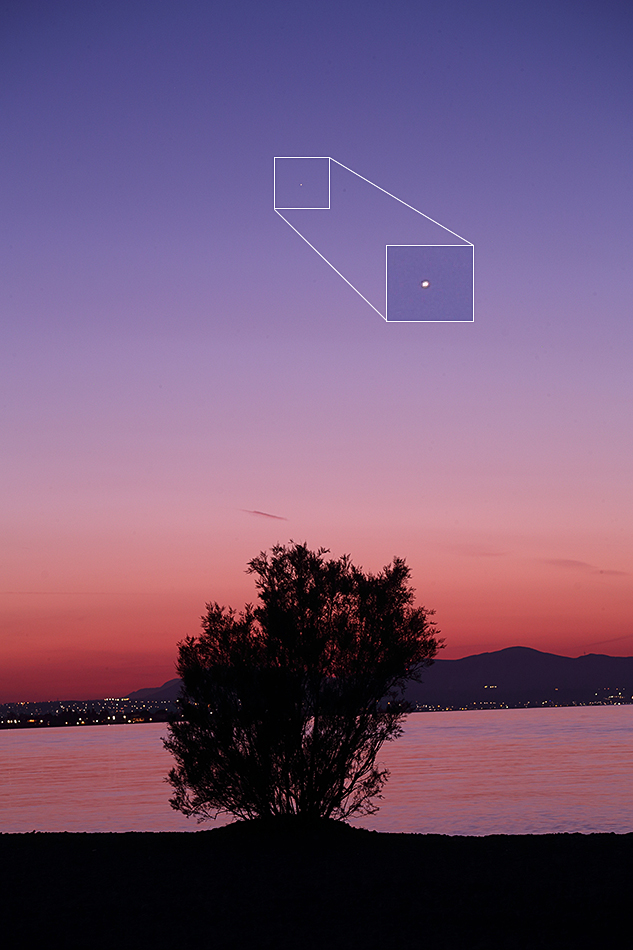

Aside from being the closest planet to the Sun, Mercury is only second to distant Pluto in being the smallest planet of
our solar system. It rotates completely around the Sun once every 88 days and has such a slow rotation about its axis
that a day on Mercury is greater in length than its year (ie. time required to orbit the Sun). The proximity of Mercury
to the Sun is responsible for its characteristic surface which is completely covered with craters, for the immense
gravitational force of the Sun attracts many comets and asteroids which inevitably also crash into Mercury due its close
proximity to the Sun. At aphelion, Mercury reaches a temperature of 285°C whereas during perihelion it surpasses 430°C
(7.5x the greatest temperature ever recorded on the surface of the Earth: 57.7°C, Lybia, Sept 1922). In contrast, the
temperature at night reaches -180°C due to the absence of any atmosphere. The only satellite mission to Mercury was
Mariner 10 which made three fly-bys between March 1974 and March 1975 when it photographed half its surface. One of the
most dominant features encountered by Mariner 10 is a plateau measuring 1300 km in diameter and is most probably due to
an impact from a 100-km wide asteroid travelling at 500,000 km per hour.
Greatest Eastern Elongation (2023): Mercury is perhaps the least-observed and most difficult
planet to see using the naked eye and this is something which predominantly has to do with the planet's incessant proximity
to the Sun, for this planet never strays by more than 18° to 28° from the Sun. However, there exist very brief windows
of opportunity during the fall and spring of each year when the planet is easily visible in the sky - around its greatest
eastern or western elongation - and thanks in part to Earth's axial tilt, the nature of Mercury's orbit and the vertical
nature of the ecliptic during these months. The first greatest eastern elongation for 2023 was on April 11, 2023 (22:00 UT),
two days prior to the result below, with Mercury
19.5
degrees east of the Sun with a diameter of 7.64 arc-seconds, a phase of about 40.5% while shining at magnitude 0.1.
Other notable opportunities during 2023 will be on Aug 9th when Mercury will once again be at greatest
eastern elongation but now at 27.4° away from the Sun; on Sept 22nd when Mercury will now be at greatest western elongation
and 17.9° away from the Sun; and, finally, on Dec 4th with Mercury at greatest eastern elongation and 21.3° away from the Sun.
The effort below involving the planet Mercury was taken from the seaside resort area of Oropos northeast of Athens and whose
history dates to the time of the golden age of ancient Greece. Oropos is best known for the sacred sanctuary Amphiareion (5th
century BC) lying in the immediate hills and which was visited by pilgrims in their desire to consult the oracle Amphiaraus
for advice and healing.
Note: For additional results involving the planet Mercury, please click
here.
|
Body: Mercury Mean Distance (A.U.): 0.387 Equatorial Diam (km): 4,878 Mass: 0.06 x Earth Volume: 0.06 x Earth Orbital Period: 87.969 days Number of Moons: 0 Orbital Eccentricity: 0.206 Orbital Inclination: 7.0° Albedo: 0.11 Diameter: 7.64 arc-secs Phase: 40.5% Magnitude: 0.11 |
 |
Date: April 13, 2023 20:36:48 UT+3 Location: Oropos, Greece Equipment: Canon EOS 6D Mark I Canon EOS EF 100-300mm f/4.5-5.6 USM @ 100 mm / f8.0 Exposure: 1 x 1.0 sec ISO 500 RAW Image Format 5472x3648 Image Size Custom White Balance Continuous Servo Mode Manual Mode Software: Digital Photo Pro V4.6.30.0 Photoshop CS6 Processing: RAW to TIFF (16-bit) Conv Resampling JPG Compression |